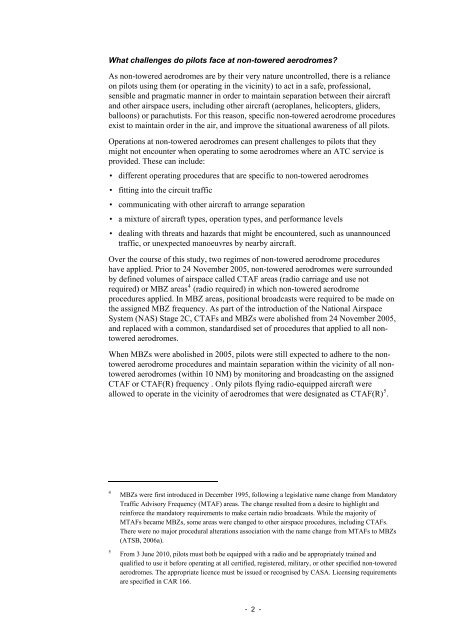Safety in the vicinity of non-towered aerodromes - Australian ...
Safety in the vicinity of non-towered aerodromes - Australian ...
Safety in the vicinity of non-towered aerodromes - Australian ...
Create successful ePaper yourself
Turn your PDF publications into a flip-book with our unique Google optimized e-Paper software.
What challenges do pilots face at <strong>non</strong>-<strong>towered</strong> <strong>aerodromes</strong>?<br />
As <strong>non</strong>-<strong>towered</strong> <strong>aerodromes</strong> are by <strong>the</strong>ir very nature uncontrolled, <strong>the</strong>re is a reliance<br />
on pilots us<strong>in</strong>g <strong>the</strong>m (or operat<strong>in</strong>g <strong>in</strong> <strong>the</strong> vic<strong>in</strong>ity) to act <strong>in</strong> a safe, pr<strong>of</strong>essional,<br />
sensible and pragmatic manner <strong>in</strong> order to ma<strong>in</strong>ta<strong>in</strong> separation between <strong>the</strong>ir aircraft<br />
and o<strong>the</strong>r airspace users, <strong>in</strong>clud<strong>in</strong>g o<strong>the</strong>r aircraft (aeroplanes, helicopters, gliders,<br />
balloons) or parachutists. For this reason, specific <strong>non</strong>-<strong>towered</strong> aerodrome procedures<br />
exist to ma<strong>in</strong>ta<strong>in</strong> order <strong>in</strong> <strong>the</strong> air, and improve <strong>the</strong> situational awareness <strong>of</strong> all pilots.<br />
Operations at <strong>non</strong>-<strong>towered</strong> <strong>aerodromes</strong> can present challenges to pilots that <strong>the</strong>y<br />
might not encounter when operat<strong>in</strong>g to some <strong>aerodromes</strong> where an ATC service is<br />
provided. These can <strong>in</strong>clude:<br />
• different operat<strong>in</strong>g procedures that are specific to <strong>non</strong>-<strong>towered</strong> <strong>aerodromes</strong><br />
• fitt<strong>in</strong>g <strong>in</strong>to <strong>the</strong> circuit traffic<br />
• communicat<strong>in</strong>g with o<strong>the</strong>r aircraft to arrange separation<br />
• a mixture <strong>of</strong> aircraft types, operation types, and performance levels<br />
• deal<strong>in</strong>g with threats and hazards that might be encountered, such as unannounced<br />
traffic, or unexpected manoeuvres by nearby aircraft.<br />
Over <strong>the</strong> course <strong>of</strong> this study, two regimes <strong>of</strong> <strong>non</strong>-<strong>towered</strong> aerodrome procedures<br />
have applied. Prior to 24 November 2005, <strong>non</strong>-<strong>towered</strong> <strong>aerodromes</strong> were surrounded<br />
by def<strong>in</strong>ed volumes <strong>of</strong> airspace called CTAF areas (radio carriage and use not<br />
required) or MBZ areas 4 (radio required) <strong>in</strong> which <strong>non</strong>-<strong>towered</strong> aerodrome<br />
procedures applied. In MBZ areas, positional broadcasts were required to be made<br />
on<br />
<strong>the</strong> assigned MBZ frequency. As part <strong>of</strong> <strong>the</strong> <strong>in</strong>troduction <strong>of</strong> <strong>the</strong> National Airspace<br />
System (NAS) Stage 2C, CTAFs and MBZs were abolished from 24 November 2005,<br />
and replaced with a common, standardised set <strong>of</strong> procedures that applied to all <strong>non</strong>-<br />
<strong>towered</strong> <strong>aerodromes</strong>.<br />
When MBZs were abolished <strong>in</strong> 2005, pilots were still expected to adhere to <strong>the</strong> <strong>non</strong><strong>towered</strong><br />
aerodrome procedures and ma<strong>in</strong>ta<strong>in</strong> separation with<strong>in</strong> <strong>the</strong> vic<strong>in</strong>ity <strong>of</strong> all <strong>non</strong><strong>towered</strong><br />
<strong>aerodromes</strong> (with<strong>in</strong> 10 NM) by monitor<strong>in</strong>g and broadcast<strong>in</strong>g on <strong>the</strong> assigned<br />
CTAF or CTAF(R) frequency . Only pilots fly<strong>in</strong>g radio-equipped aircraft were<br />
allowed to operate <strong>in</strong> <strong>the</strong> vic<strong>in</strong>ity <strong>of</strong> <strong>aerodromes</strong> that were designated as CTAF(R) 5 .<br />
4 MBZs were first <strong>in</strong>troduced <strong>in</strong> December 1995, follow<strong>in</strong>g a legislative name change from Mandatory<br />
Traffic Advisory Frequency (MTAF) areas. The change resulted from a desire to highlight and<br />
re<strong>in</strong>force <strong>the</strong> mandatory requirements to make certa<strong>in</strong> radio broadcasts. While <strong>the</strong> majority <strong>of</strong><br />
MTAFs became MBZs, some areas were changed to o<strong>the</strong>r airspace procedures, <strong>in</strong>clud<strong>in</strong>g CTAFs.<br />
There were no major procedural alterations association with <strong>the</strong> name change from MTAFs to MBZs<br />
(ATSB, 2006a).<br />
5 From 3 June 2010, pilots must both be equipped with a radio and be appropriately tra<strong>in</strong>ed and<br />
qualified to use it before operat<strong>in</strong>g at all certified, registered, military, or o<strong>the</strong>r specified <strong>non</strong>-<strong>towered</strong><br />
<strong>aerodromes</strong>. The appropriate licence must be issued or recognised by CASA. Licens<strong>in</strong>g requirements<br />
are specified <strong>in</strong> CAR 166.<br />
- 2 -
















